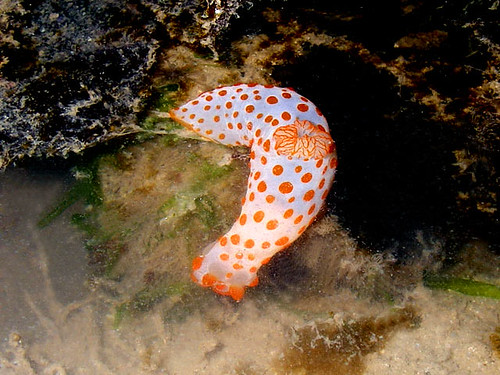
From top-left in clockwise direction, we have the polka dot nudibranch (Jorunna funebris), a marginated glossodoris nudibranch (Glossodoris atromarginata), a bohol nudibranch (Discodoris boholensis) and a pustolose phyllid nudibranch (Phyllidia pustolosa).
NF#2: Nudibranchs are related to snails. Little baby nudibranchs are born with shells, but they lose them when they become adults.
Thoughtful Question: Having a soft body without a shell makes the nudibranch very vulnerable to predators. How do you think they protect themselves?
Many nudibranch secretes chemicals when they are threatened. The chemicals may either make them very distasteful or even toxic!
That's why nudibranchs are not good for the aquarium! The chemicals they release may caused the other animals to be very stressed, or even die!
Some nudibranchs are also able to store the stinging cells of the hydriods or other cnidarians they feed on in their cerata.
Many nudibranchs are brightly coloured to warn the predators not to eat them, and some nudibranchs are also coloured to match their surrounding, which allow them to camouflage from the predators.
NF#3: Nudibranchs are carnivores, each species usually feed on a particular type of prey, which is usually something that can't move, like sponges, ascidians, hard corals, soft corals, sea anemones, zoanthids, peacock anemones, sea pens and eggs of other creatures. Some nudibranchs, such as the Gymnodoris nudibranch (Gymnodoris sp.) also feed on other slugs).
Here is a Gymnodoris rubropapulosa.

Too Much Information:
There are four sub-orders of nudibranchs - Doridina, Dendronotina, Arminina and Aeolidina.
Doridina is the biggest sub-order. You can identify dorids from the flower-like gills on its back. Dorids commonly seen on our southern shores include: Jorunna funebris, Glossodoris atromaginata, Gymnodoris rubropapulosa, Phyllidiella nigra and Phyllidiella pustulosa.
Dendronotids are charactierised by the two rows of branch-like structures called cerata on their backs. One of the dendronotids found on our southern shores is Bornella stellifer (see below).

Arminina is the smallest and most diversified suborder. The body is flattened and elongate with a mantle which extends into an oral veil. The gills are often along the side under under the mantle. One arminids seen on our southern shore is Armina semperi (see below).

Aeolids usually has thin bodies with projections (cerata) on their backs. One common aeolid we've seen on our southern shores is Pteraeolidia ianthina (see below).

How they "smell":
Many nudibranchs have two pairs of tentacles. One pair is near the mouth. The second pair is further back and called rhinophores. Rhinophores are believed to detect chemicals in the hunt for prey and mates.
Reproduction:
Nudibranchs are simultaneous hermaphrodites, meaning each slug has both male and female reproductive organs at the same time. They practice internal fertilisation, and do it side-by-side, facing opposite directions. Sometimes, one will act as the male partner and the other as the female. At other times, they may fertilise each other. After mating, they go their separate ways and each lays its egg mass. Nudibranchs usually die after laying their eggs. In some cases, the eggs are laid on or near a food source and the young ) hatch fully developed and commence feeding. In other cases, the young hatch and are carried in the current. They eventually settle unto a food source and continue developing into adults. The juvenile nudibranchs usually have shells, but lose them eventually when they turn into adult nudibranchs.

No comments:
Post a Comment